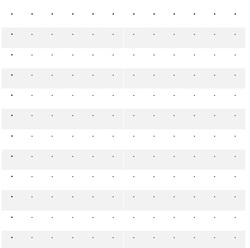Dotty Lines
 On a 13 by 13 square grid of dots (where all dots are length 1 apart) a line can be drawn from any point to any point. How many different (positive) integer lengths are there for this line?
On a 13 by 13 square grid of dots (where all dots are length 1 apart) a line can be drawn from any point to any point. How many different (positive) integer lengths are there for this line?
This section requires Javascript.
You are seeing this because something didn't load right. We suggest you, (a) try
refreshing the page, (b) enabling javascript if it is disabled on your browser and,
finally, (c)
loading the
non-javascript version of this page
. We're sorry about the hassle.
3 solutions
Actually, since it is a 12 x 12 grid, the longest length you can make is 11, causing the answer to be 11.
Log in to reply
Thanks for pointing that out; I've changed it to a 13x13 grid.
It is a 13x13 grid, so 1 to 12. And then u have 13 from the triangle with sides 5, 12 and 13. And 15 from the triangle 9, 12 and 15.
Sorry, the answer is wrong. You can form 12 on any one line. Then use Pythagorian triples to produce other number. 3, 4 and 5. 5, 12 and 13. 9, 12 and 15. So the smallest answer is 15. However, the diagonal 10 (from 6 and 8) can be viewd as different than a straight 10.
Log in to reply
Sorry, you might have counted 5 twice? Also, I said different lengths, not different types of lines; hence the only lengths are 1 to 12, 13 and 15 which gives the answer 14.
The question is, "How many different integer lengths are there for this line?" The horizontal-or-vertical 10 is a different line from the oblique (diagonal) 10, but they are the same length, even if the LOGO turtle doesn't round the latter off correctly.
How does this question even have that high of a rating?!
I am trying a guess out here . Suppose you connect three dots diagonally here then that length would be sqrt(4+4)=2.82, four dots then the length would be sqrt(9+9) and so on
total 1 to 13 we can make 13 different line s but and we can also make length of 15(as per Pythagoras triples (9,12,15) which is inclined so total 13+1=14 different lines can be made
On a grid 13x13, we can make 12 different lines... The lenght 13 we got from the triangle 5, 12 and 13.
Counting trivial lines we have 1 2 . Trivial lines are either horizontal or vertical. Now the only other integer lines that are not vertical or horizontal are primitive Pythagorean triples with a and b of a 2 + b 2 = c 2 being less then or equal to 13. There are only 2 triples that fit this criteria, namely ( 3 , 4 , 5 ) and 5 , 1 2 , 1 3 . Therefore our final answer is 1 4
The length of the line has a minimum of 1, and a maximum of ⌊ 1 2 2 + 1 2 2 ⌋ = 1 6 . However, after the horizontal lengths from 1 to 12, longer lengths can only be made by forming diagonals. It follows that these lengths hence must be the hypotenuses of Pythagorean Triples. Only 13 in (5,12,13) and 15 (9,12,15) can fit in the 12 by 12 grid, therefore the answer is 14.